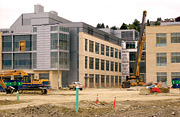
Each of the building's air-handling systems use an aerodynamic and aeroacoustic fan system (Compact(tm) Space Fan Systems from M&I Air Systems Engineering, a division of M&I Heat Transfer Products Ltd.). In all, Buildings A, B, C, D, and J on the Immunex campus house 22 supply units and five return units that use unique aerodynamic inlet and outlet configurations. The supply units range in capacity from 30,000 cfm to 51,000 cfm.
The starting point: vaneaxial fans
On the systems supplied to Immunex, aerodynamically streamlined inlet concentrator/silencers prevent much of the potential noise from occurring. The fans are engineered and manufactured by American Fan Company/Woods, a FlaktWoods company.These inlet units gradually accelerate the intake air to the fans' annular velocity without generating turbulence or flow separation. They deliver the air perpendicular to the fans' annulus areas and are designed to minimize impact losses at the fans' hubs.
The use of acoustical materials and the inclusion of resonators mechanically tuned to the fan blades' passage frequencies further decrease sound levels inside the mechanical rooms. On the outlet side of the fans are regain attenuators, which are computer-designed to optimize aerodynamics and aeroacoustics. In each system, the velocity of the air leaving the fan is gradually reduced to the duct and plenum velocity using multiple splitters and/or turning vanes, thereby maximizing the static regain of the fan's annular velocity pressure.
Meeting Immunex's specs
When Immunex and its engineering firm drafted the air-handling requirements for the Seattle site, high energy performance, low noise and vibration levels, and simplified maintenance were among the most important criteria. The fans were chosen because aerodynamically designed regain attenuators on the Compact systems are designed to achieve as high as 80 static regain of a fan's annular velocity pressure. As a result, energy consumption is 30% to 50% less than for conventional systems of equal capacity, according to the manufacturer.Salman Akhtar, P.E., engineering manager with M&I, said the Compact air handlers also met Immunex's low noise requirements. "The use of acoustical materials and resonators on systems already made quiet by a combination of aerodynamic features, and the lack of lines-of-sight from the intakes and outlets to the fans achieves this objective."
With respect to vibration, because of the aerodynamic features of the inlets and outlets used in these Compact systems, the vaneaxial fans built into them generate displacements as low as 0.02 mil (peak). In addition, the fans are mounted on four 98% efficient vibration isolators to minimize the transmission of vibration to a building's floor or other mounting structure.
The case of Building C
In Building C on the Seattle campus, there are four 44,000-cfm-capacity supply units. According to Akhtar, there was intense competition to supply these four, as well as the remaining 23 air handlers. M&I subjected a conventional design to analysis using a computational fluid dynamics (CFD) flow-modeling program. "The modeling revealed areas of pressure drop at the fan inlet, its outlet, and at various fittings within the proposed air-handling unit. Besides pressure losses, the CFD modeling displayed other phenomena such as boundary layer separation, vena contracta, Venturi formations, and vortices," he said.Four air handlers were delivered to Building C, and all met customer capacity requirements. However, instead of the 100-hp motors required for the conventional design, the air handlers were outfitted with 60-hp motors. Of course, the difference in energy consumption is significant. Also, since smaller motors in the airstream mean less heat in the airstream, lower hp motors in air-handing equipment mean a lower cooling load for the entire building. The results achieved using Compact air handlers in Building C help account for the widespread use of these kinds of systems in Buildings A, B, D, and J as well.ES
